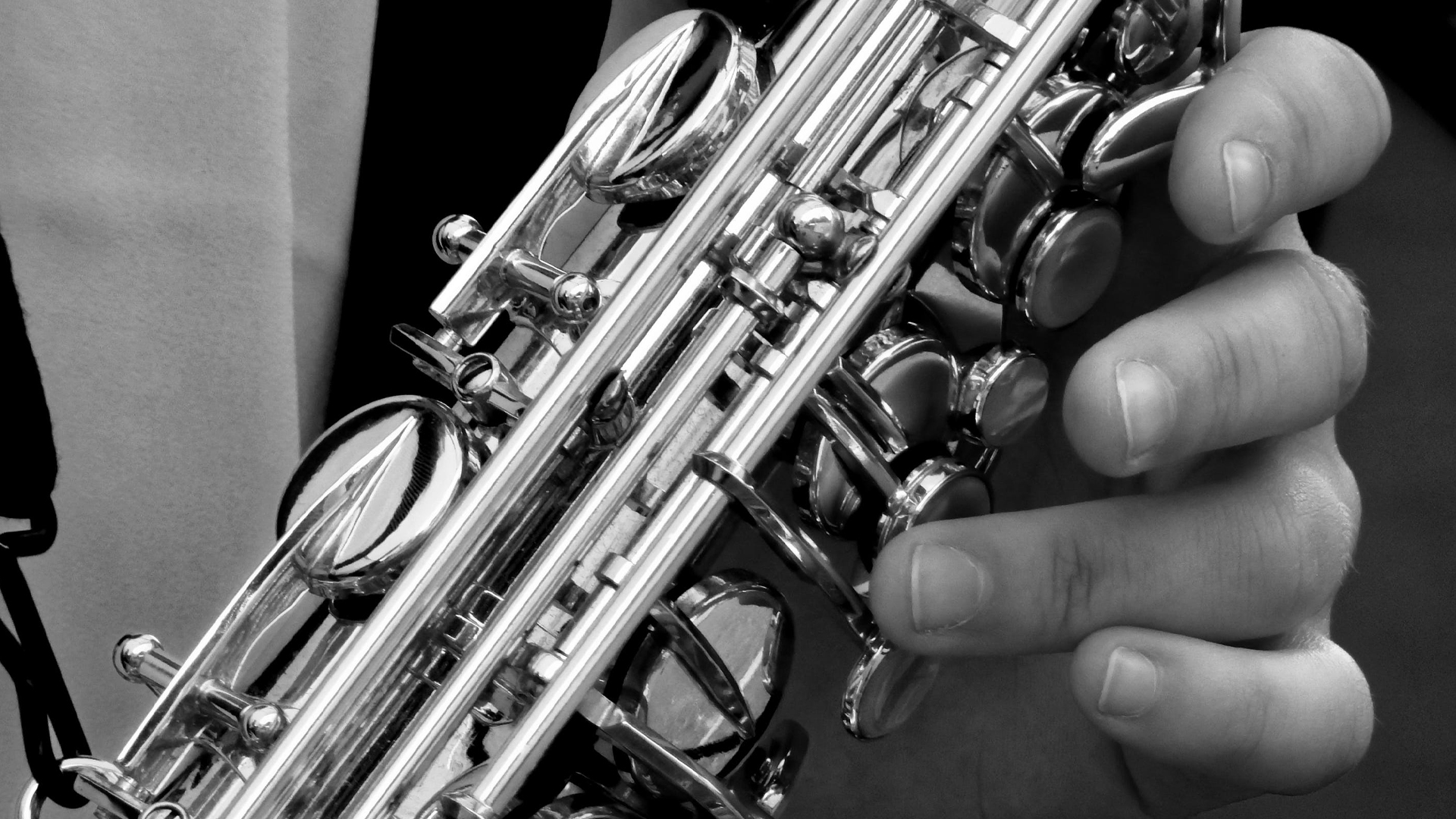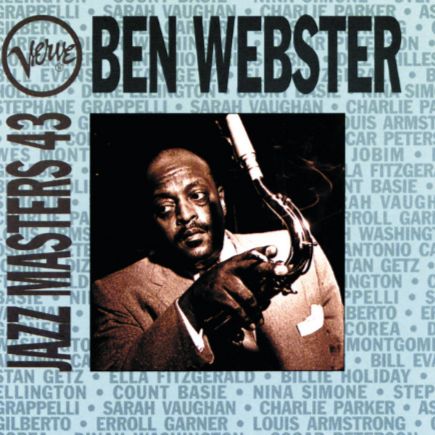Ben Webster: souffle puissant, tendresse inégalée
Surnommé The Frog pour ses yeux globuleux, Ben Webster occupe une place singulière dans l’histoire du jazz. Saxophoniste ténor de premier plan, il s’impose dès les années 1930 aux côtés de figures comme Coleman Hawkins et Lester Young. Héritier du swing, il se distingue par un jeu à la fois robuste et d’une douceur bouleversante, un équilibre rare entre intensité et lyrisme qui marquera durablement plusieurs générations de musiciens.
Né à Kansas City, alors bouillonnante de musique et de rencontres entre blues et jazz, Ben Webster grandit dans un environnement propice à l’éclosion de son talent. Il commence par apprendre le violon et le piano, avant de se tourner vers le saxophone ténor, influencé par Budd Johnson. Sa carrière décolle rapidement: il intègre d’abord l’orchestre de Bennie Moten, l’un des meilleurs du Midwest, puis celui de Fletcher Henderson, où il affine son sens du phrasé et son aisance rythmique.
Mais c’est en rejoignant l’orchestre de Duke Ellington en 1940 que Ben Webster trouve pleinement sa voix. Entre 1940 et 1943, période faste pour le big band, il s’impose comme une figure essentielle de la section de saxophones – aux côtés de Johnny Hodges et Russell Procope – contribuant à en faire l’une des plus brillantes de l’histoire du jazz.
Avec Ellington, il développe un style immédiatement reconnaissable: une attaque franche, incisive sur les tempos rapides, et une sonorité veloutée, presque murmurée, sur les ballades. Des pièces comme Satin Doll et In a Mellowtone, écrites pour lui par Ellington et Billy Strayhorn, lui offrent un écrin sur mesure. Son interprétation de Cotton Tail est devenue une référence en matière de swing nerveux, tandis que ses solos sur Chelsea Bridge et Prelude to a Kiss révèlent une profondeur émotionnelle et une finesse d’intonation rares.
Cette capacité à naviguer entre fougue et tendresse, à conjuguer puissance et retenue, confère à Webster une voix unique dans le paysage du jazz. Après son départ de l’orchestre en 1943, il devient une figure incontournable de la scène new-yorkaise, multipliant les collaborations avec ses pairs, notamment Coleman Hawkins et Lester Young. À la différence du jeu flamboyant de Hawkins, Webster privilégie un souffle ample, un phrasé feutré, presque vocal, qui confère à son instrument une humanité saisissante.
L’album King of the Tenor (1953) constitue une synthèse exemplaire de son art, mêlant swing vigoureux et ballades d’une élégance rare. En 1964, fatigué par le climat américain, Webster s’installe en Europe. D’abord en Hollande, puis définitivement à Copenhague à partir de 1969, il y trouve une reconnaissance renouvelée et un public fidèle, à la hauteur de son immense talent.
Ben Webster: aliento poderoso, ternura inigualable
Apodado The Frog por sus ojos saltones, Ben Webster ocupa un lugar singular en la historia del jazz. Saxofonista tenor de primer orden, se impuso ya en los años 30 junto a figuras como Coleman Hawkins y Lester Young. Heredero del swing, se distinguió por un estilo robusto y al mismo tiempo profundamente delicado, un equilibrio poco común entre intensidad y lirismo que influiría en varias generaciones de músicos.
Nacido en Kansas City, ciudad entonces efervescente de música y de encuentros entre el blues y el jazz, Ben Webster creció en un entorno propicio para el desarrollo de su talento. Comenzó estudiando violín y piano, antes de decantarse por el saxofón tenor, influido por Budd Johnson. Su carrera despegó rápidamente: primero se unió a la orquesta de Bennie Moten, una de las mejores del Medio Oeste, y luego a la de Fletcher Henderson, donde perfeccionó su fraseo y su dominio rítmico.
Pero fue al integrarse en la orquesta de Duke Ellington en 1940 cuando Ben Webster encontró plenamente su voz. Entre 1940 y 1943, uno de los periodos más fértiles del big band, se consolidó como figura clave de la sección de saxofones —junto a Johnny Hodges y Russell Procope—, contribuyendo a formar una de las secciones más brillantes de la historia del jazz.
Con Ellington, desarrolló un estilo inconfundible: ataque firme e incisivo en los tempos rápidos y una sonoridad aterciopelada, casi susurrada, en las baladas. Piezas como Satin Doll e In a Mellowtone, escritas para él por Ellington y Billy Strayhorn, le ofrecieron un marco a medida. Su versión de Cotton Tail se convirtió en referencia del swing más vibrante, mientras que sus solos en Chelsea Bridge y Prelude to a Kiss revelan una sensibilidad emocional y una fineza de entonación excepcionales.
Esa capacidad para alternar ímpetu y ternura, para combinar fuerza y contención, dio a Webster una voz única dentro del panorama jazzístico. Tras dejar la orquesta en 1943, se convirtió en una figura esencial de la escena neoyorquina, colaborando con sus pares, especialmente Coleman Hawkins y Lester Young. A diferencia del estilo más brillante y ostentoso de Hawkins, Webster favorecía un aliento amplio y un fraseo suave, casi vocal, que daba a su instrumento una humanidad conmovedora.
El álbum King of the Tenor (1953) ofrece una síntesis ejemplar de su arte, combinando un swing poderoso con baladas de gran elegancia. En 1964, cansado del ambiente estadounidense, Webster se trasladó a Europa. Primero vivió en los Países Bajos, luego se instaló definitivamente en Copenhague en 1969, donde encontró un reconocimiento renovado y un público fiel, a la altura de su inmenso talento.
Ben Webster: respiro potente, tenerezza ineguagliabile
Soprannominato The Frog per i suoi occhi sporgenti, Ben Webster occupa una posizione unica nella storia del jazz. Sassofonista tenore di prim’ordine, si affermò già negli anni Trenta accanto a figure come Coleman Hawkins e Lester Young. Erede dello swing, si distinse per uno stile insieme vigoroso e di straordinaria dolcezza: un equilibrio raro tra intensità e lirismo che influenzò profondamente generazioni di musicisti.
Nato a Kansas City, all’epoca un crocevia effervescente di blues e jazz, Ben Webster crebbe in un ambiente ideale per lo sviluppo del suo talento. Iniziò studiando violino e pianoforte, prima di dedicarsi al sassofono tenore, sotto l’influenza di Budd Johnson. La sua carriera decollò rapidamente: entrò prima nell’orchestra di Bennie Moten, una delle migliori del Midwest, e poi in quella di Fletcher Henderson, dove affinò il suo fraseggio e la padronanza ritmica.
Ma fu nel 1940, entrando nell’orchestra di Duke Ellington, che Ben Webster trovò pienamente la propria voce. Tra il 1940 e il 1943, periodo d’oro per il big band, divenne figura chiave della sezione sassofoni —insieme a Johnny Hodges e Russell Procope— contribuendo a renderla una delle più celebri nella storia del jazz.
Con Ellington, sviluppò uno stile immediatamente riconoscibile: attacco deciso e tagliente sui tempi veloci, sonorità vellutata e quasi sussurrata nelle ballate. Brani come Satin Doll e In a Mellowtone, scritti appositamente per lui da Ellington e Billy Strayhorn, ne mettono in risalto le qualità. La sua interpretazione di Cotton Tail è diventata un modello di swing frenetico, mentre i suoi assoli su Chelsea Bridge e Prelude to a Kiss rivelano una profondità emotiva e un’intensità timbrica eccezionali.
Questa capacità di passare dalla passione alla tenerezza, di fondere potenza ed eleganza, conferisce a Webster una voce davvero unica nel panorama jazzistico. Dopo aver lasciato l’orchestra nel 1943, diventò una figura centrale della scena newyorkese, collaborando con artisti come Coleman Hawkins e Lester Young. Diversamente dallo stile più scintillante di Hawkins, Webster preferiva un suono ampio, un fraseggio ovattato, quasi vocale, che donava al suo strumento una sorprendente umanità.
L’album King of the Tenor (1953) rappresenta una sintesi esemplare del suo stile, mescolando swing potente e ballate di grande raffinatezza. Nel 1964, stanco del clima americano, Webster si trasferì in Europa. Dopo un primo periodo in Olanda, si stabilì definitivamente a Copenaghen nel 1969, dove trovò un nuovo riconoscimento e un pubblico fedele, all’altezza del suo immenso talento.
Ben Webster: powerful breath, unmatched tenderness
Nicknamed The Frog for his bulging eyes, Ben Webster holds a distinctive place in jazz history. A leading tenor saxophonist, he made his mark in the 1930s alongside figures like Coleman Hawkins and Lester Young. A true heir to the swing tradition, he stood out with a sound that was both forceful and remarkably tender—an uncommon balance of power and lyricism that left a lasting impact on generations of musicians.
Born in Kansas City, then a vibrant hub where blues and jazz intersected, Ben Webster grew up in an environment rich in musical opportunities. He began by studying violin and piano, before turning to the tenor saxophone under the influence of Budd Johnson. His career took off quickly: he first joined Bennie Moten’s band, one of the Midwest’s finest, then Fletcher Henderson’s orchestra, where he honed his phrasing and rhythmic finesse.
But it was in 1940, upon joining Duke Ellington’s orchestra, that Ben Webster truly found his voice. Between 1940 and 1943, a golden period for the big band, he emerged as a key figure in the saxophone section—alongside Johnny Hodges and Russell Procope—helping to shape one of the most brilliant reed sections in jazz history.
With Ellington, he developed an unmistakable style: crisp and assertive on uptempo numbers, soft and velvety on ballads. Pieces like Satin Doll and In a Mellowtone, composed for him by Ellington and Billy Strayhorn, were tailor-made to showcase his tone. His performance of Cotton Tail remains a benchmark in driving swing, while his solos on Chelsea Bridge and Prelude to a Kiss reveal exceptional emotional depth and subtlety.
His ability to move seamlessly between fire and tenderness, to blend strength with restraint, gave Webster a singular voice in the jazz world. After leaving the Ellington orchestra in 1943, he became a mainstay of the New York jazz scene, collaborating with peers like Coleman Hawkins and Lester Young. In contrast to Hawkins’s more flamboyant approach, Webster favored a broad, mellow tone and a phrasing almost vocal in quality, lending his instrument a deeply human character.
The 1953 album King of the Tenor is a quintessential expression of his artistry, combining vigorous swing with exquisitely elegant ballads. In 1964, weary of the American climate, Webster moved to Europe. After a period in the Netherlands, he settled permanently in Copenhagen in 1969, where he found renewed recognition and a devoted audience equal to his immense talent.


